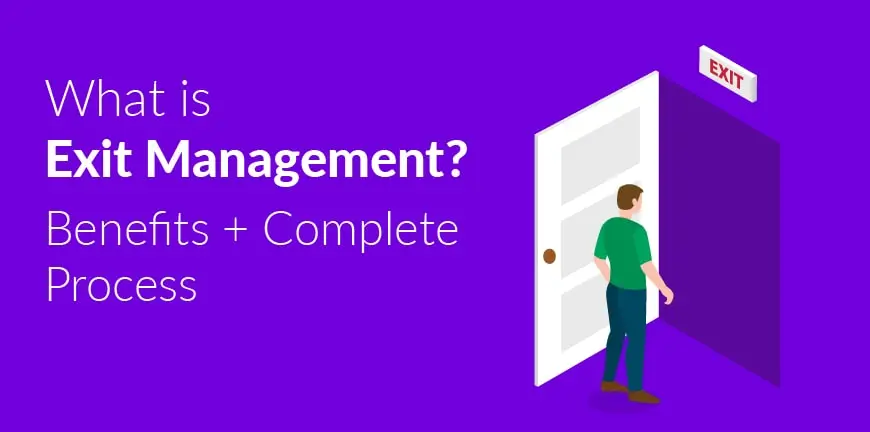
Hyderabad Becoming a Life Sciences Hub in India in 2025
22/11/2024
How to Streamline Payroll Management in HR in 2025?
26/11/2024Introduction
Exit Management refers to effectively managing all the procedures involved during the exit of an employee due to voluntary resignation or termination of employment. This is one of the most important processes to be carried out by the HR department as all the resources the organization would have provided must be retrieved before the employee exits.
But why is the exit management process so important? Relieving your employees from their duties in the nicest way possibly and smoothening their exit, helps in retaining the goodwill of the company. It highlights your care and commitment towards employees and bodes well for when you are hiring new employees. Exit Management helps the HR in gathering and organizing data about the employees that are exiting and use the feedback in times of contingencies. So its not just essential but beneficial as well.
What are the Benefits of Exit Management System?
There is a myriad of benefits of carrying out the employee exit management process effectively. Some of the benefits of implementing an effective exit management process are-
- Collect, analyse and store critical information concerning the employees
- Retrieve official and crucial information and data from employees that are exiting the organization
- The right exit management process can help reduce losing or theft of important information.
- You’ll get quite the insight about your existing work culture from these employees
- Make changes in the work culture for the future growth of the organization
- Contribute to strategic planning framed by the management
- A good exit management system means a better employee experience
- Creates a good impression in the minds of employees
- You get valuable feedback from the exiting employees about their journey in your organization
What is the Process of Exit Management?
The Exit Management process is set of steps that the HR follows during the exit of an employees. It is essentially a well thought out exit management plan that must be executed well.
1. Address the resignation
The first thing to acknowledge when there is an exit of an employee taking place is to address their letter of resignation sent. Its essential that the management is active and responds in the right manner during these sensitive circumstances. Managing the situation well can help find a befitting solution that is beneficial both organization and the employee.
Offering the right response about the acceptance or rejection of an employee’s resignation offers time to come up with the right solution to retain resourceful staff but also showcases the promptness of management.
2. Automate the offboarding process
Offboarding must be digitalized in order to avoid the tedious lengthy process of documentation and paperwork. Digitalization of the process can also ensure accuracy and avoid complexities. Also, it is a systematic way to evaluate the payroll dues to be cleared while offering the exiting their full and final settlement. This can ensure the employees exit on a good note. Another important factor is the HR can obtain error-free assessment of data and records forwarded by the departing employees.
3. Preparation of a checklist that includes handing over of equipment and resources
Once the exit management is digitalized, you must prepare a checklist that includes a detailed list of all equipment, assets and other organisational logins that were provided to the departing employee during their tenure. For the handing over of data and documents, the management is to prepare a checklist of all the assets and resources the employee who is exiting has in their possession. The checklist can help the management ensure that nothing us missed and the transition happens smoothly.
4. Ensure the transfer of knowledge
The checklist will have all the documents and responsibilities acquired by the exiting employee during the tenure of his employment that must be retrieved back before his departure. Employers should ensure adequate transfer of all the exit data to the new employee who will serve as a replacement for the leaving employee. The automated offboarding will make sure that all the information and knowledge is safely stored in the software so that it can be accessed at any time, reducing the risk of theft of data.
5. Final documentation
The HR must collect all the resignation forms or termination acknowledge forms if any and update the employment records including the last working day of the employee. Make sure that you settle all of the pending payment you have towards to the exiting employee including final salary, bonuses, unused leaves, gratuity etc, provide the, with tax related documents including form 16 or w-2. Also, ensure that you convey all the post-employment benefits like PF transfer, health insurance continuation etc.
6. Communicate Departure to Other Departments & Completing Paper Work
The manager of the concerned department of the leaving employee is required to inform other departments such as IT, Administration, and Finances, about the exit date. The aforementioned departments are needed to be informed because IT will block access to official IDs, so the misuse of accounts can be eliminated.
The admin will collect all the official gadgets and documents before the departure and approves the finance wing to clear dues. The signing of official documents before departure to not give something amiss and authenticate the handed-over documents is an important step in the offboarding process.
7. Conduct an effective exit interview
Bear in mind the exit interview must be more of a friendly conversation rather than a proper interview. Be kind, composed and instead of bombarding them with typical questions allow the employee a chance to say their piece. Gather feedback about their experience in your organization, identify areas for improvement in policies, management or culture. Make sure everything they say is confidential and secure the documentation.
8. Legal Compliance
Ensure that you adhere to all the labour laws, employment agreements and the local legal requirements. There is no space for mistakes here as noncompliance can lead to legal issues or fines or penalties. Also, provide the employee with all mandatory, relieving documents including the service letter, relieving letter and any others if present.
9. Post exit relationship
As an employer, it’s important to maintain positive relations, especially if the employee could return (boomerang employee) or act as an ambassador for the organization. Stay in touch through alumni networks if applicable.
The above mentioned are some of the key features of the exit management process that can help ensure smooth transitions while maintaining organizational integrity and employee goodwill.
Why Choose Alp Consulting to Help with Your Exit Management Process?
Choosing to engage in expert third-party HR services like Alp Consulting to manage your company’s exit management process can offer you a strategic advantage especially if they are seeking efficiency, compliance, and employee-centric offboarding. By outsourcing this critical HR function to us, companies can benefit from expert processes, technology-driven solutions, and unbiased handling of exits, ensuring both departing employees and the organization are treated with professionalism.
Alp Consulting can help reduce administrative burdens, minimizes legal risks, and facilitates smooth transitions, allowing internal teams to focus on core business objectives. Ultimately, investing in our exit management solution reflects a commitment to operational excellence and maintaining a positive employer brand, even as employees move on.
Frequently Asked Questions
1. What is the employee exit process?
An employee exit management system is a process that a company follows after an employee resigns or is terminated. It is an offboarding process that ensures all necessary steps are taken between the time an employee resigns and when they officially leave the business.
2. What is an employee exit checklist?
An employee exit checklist is essentially a leaver’s checklist, it is a list of all the actions you need to take whenever someone resigns or is made redundant from your organisation.
3. What are the objectives of exit management?
The goal of the exit management strategy is to ensure a positive and respectful departure for the employee, and at the same time allowing the company to manage the transition and plan for future staffing needs.
Contact Us For Business Enquiry

Rajkumar Shanmugam
Rajkumar Shanmugam is the Head of HR at ALP Consulting, bringing over 19 years of comprehensive HR leadership experience across India and international markets. His expertise spans talent acquisition, employee relations, performance management, compliance, and HR transformation. Rajkumar has a proven track record of driving people-centric initiatives, enhancing workplace culture, and aligning HR strategy with business goals. With extensive experience in US staffing operations and global mobility, he continues to lead organizational excellence through innovation and employee engagement.




